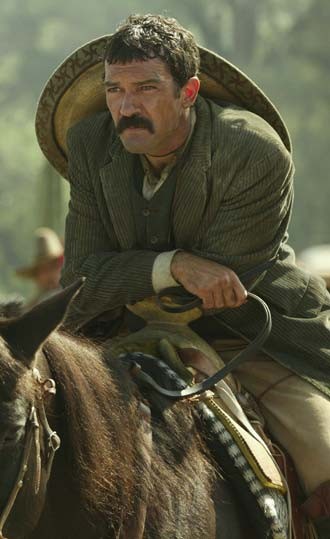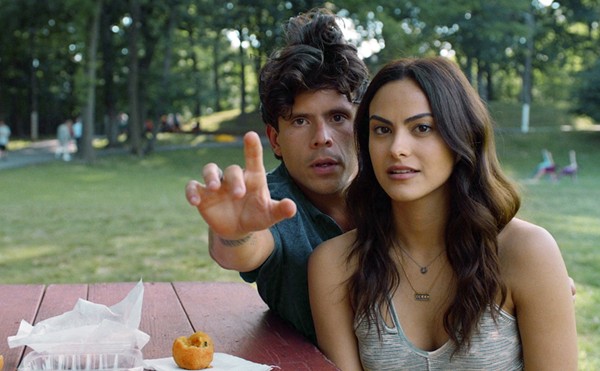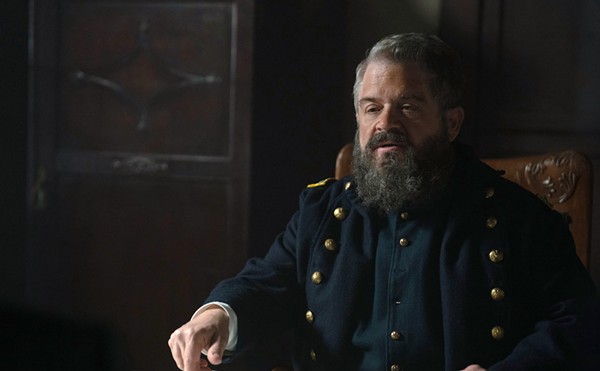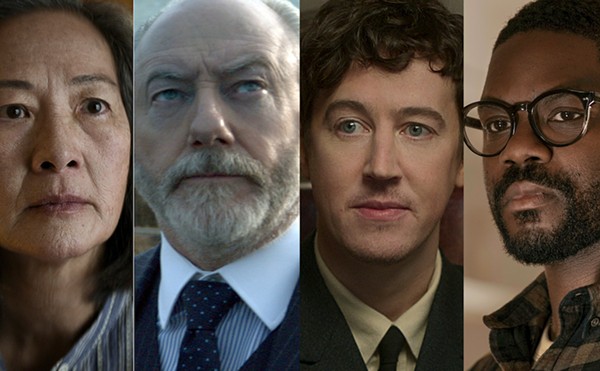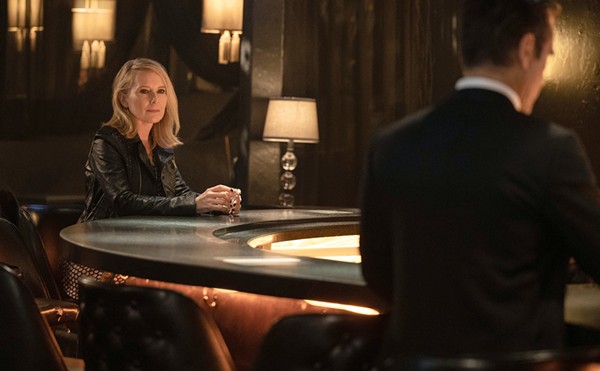| Antonio Banderas in And Starring Pancho Villa as Himself Courtesy photo |
HBO has taken a little-known historical event and blown it beyond recognition in And Starring Pancho Villa as Himself, which premieres on HBO Cable Network at 8:30 p.m. on Sunday, September 7. The film chronicles Mexican revolutionary General Francisco "Pancho" Villa's attempt to raise money for his forces by selling Hollywood exclusive rights to his real-life battleground.
Instead of enlisting a Mexican or Mexican-American director - such as Alfonso Cuarón of Y Tu Mamá También fame or Alejandro González Iñárritu from Amores Perros - to reflect on Villa, the man, the myth, in a film made to draw on the large number of Latino HBO subscribers, the cable channel appointed Bruce Beresford. Beresford, who directed the excellent Aussie film, Breaker Morant, is apt at handling battle and crowd scenes, but doesn't have a clue when it comes to portraying Mexico and its history.
In the film, Villa agrees to a controversial clause that stipulated he perform his fighting during daylight hours, and that he would re-enact battle scenes if the cameraman was unable to get good footage. In essence, he would be putting his men in harm's way to satisfy the moviemakers. Actually there was no such clause. Historian and Villa biographer Friedrick Katz is most specific in his examination of the agreement: "What the contract did specify was that Mutual was granted exclusive rights to film Villa's troops in battle, and that Villa would receive 20 percent of all revenues that the films produced."
And Starring Pancho Villa as Himself is told through the eyes of Frank Thayer, a young Harvard graduate, who works for his Uncle Harry Aitkin, an associate of film pioneer D.W. Griffith, the filmmaker responsible for lauding the Ku Klux Klan in his groundbreaking Birth of a Nation. Griffith had also portrayed Mexicans as "greasers" in his 1908 film The Greaser's Gauntlet, and later in The Greaser, directed by his actor Raoul Walsh. To these pioneers, making a gritty documentary of a peon uprising south of the border must have sounded like a brilliant idea.
In the title role, a filthy, swarthy Antonio Banderas - hidden behind two weeks' growth of facial hair - is unbelievable as Villa, who was not a Hollywood stereotype in either clothing or manner. The filmmakers would have audiences believe that Villa bonds with Thayer, taking his own Virgin of Guadalupe off his sweaty neck and giving it to this wannabe film mensch. It soon becomes evident who plays the second banana.
| AND STARRING PANCHO VILLA AS HIMSELF Dir. Bruce Beresford; writ. Larry Gelbart; feat. Antonio Banderas, Eion Bailey, Michael McKean, Colm Feore, Alan Arkin (TVMA) |
The film does have one true Hollywood moment in which the movie Villa almost utters the hackneyed words: "I'm ready for my close-up, Señor Griffith." After keeping a film crew waiting, the general emerges in whiteface as he sits in a faux presidential chair and delivers an apologia pro vita sua. He laments any death or destruction since all that he did, he did for love of his beloved Mexico. Of course, the real Villa never aspired to become president of Mexico, but in the throes of his hubris, the cardboard Villa gives the American filmmakers what they wanted: melodrama in one take.
What most people think of Francisco "Pancho" Villa often depends on which side of the border - or even which side of town - you live in. One can find a devotional candle with Villa's visage at any local mercado. San Pancho? Well, not really. But the prayer on the back of the candle implores the "great revolutionary general" to give the supplicant the same type of courage he showed in front of his enemies.
Perhaps the filmmakers should have bought a dozen of these votive candles, for the real Villa manages to escape from the gringos again. •
MAKING REVISIONIST HISTORY
It isn't surprising that HBO would select San Antonio to screen its upcoming film, And Starring Pancho Villa as Himself. After all, three seminal figures of the Mexican Revolution once lived here: anarchist organizers the Flores Magón Brothers; future Mexican president Francisco Madero; and Anita Brenner, the author of the Revolution's first classic, The Wind That Swept Mexico.
As Joshua D. Maurer, one of the film's executive producers, sat for an interview, he proffered a talisman: a retouched photo postcard of Villa issued by the Mutual Film Company. In the photo, Villa's skin tone has been lightened, his moustache and eyebrows trimmed to make him more presentable to an American audience. It is this story that the film tells.
Maurer (who also produced Introducing Dorothy Dandridge and The Pentagon Papers) researched the $23 million project for over six years. Yet, some may find the film both historically insensitive and politically incorrect - including Spaniard Antonio Banderas' lean portrayal of the hefty Mexican Villa.
The film has a nine-year gap in its storyline - traipsing from the premiere of the 1914 Mutual film, The Life of General Villa, to a violent depiction of Villa's death in 1923.
"It was very hard to condense this story into a two-hour film," Maurer says, "but I am hopeful the spirit of the changing of Villa's fortune was conveyed. I agree perhaps more questions are raised than actually answered."
Indeed. While the myth of Villa lives, so do questions. Who stole Villa's head? Are the rest of his remains actually buried in Mexico City?
In his superb The Life and Times of Pancho Villa, historian Friedrich Katz relates a possible fate of Villa's head. "It had been acquired by Skull and Bones, a secret society at Yale University `to which George Bush, subsequently president of the United States, once belonged.`"
"There are a lot of unsubstantiated but very interesting theories out there," Maurer opines, "including the one that Pancho is still buried in Parral."
Still, the burning question remains. Who killed Villa and why?
Both journalist John Reed in Insurgent Mexico and Katz point to complicity between oil-rich property owners in Mexico and the Mexican government under Obregón.
"Of those properties, 90 percent was owned by foreigners," the Reed character states. Ditto Maurer. "Seventy percent of that was owned by Americans like Edward Doheny, Rockefeller, Carnegie, and William Randolph Hearst, whose holdings included a ranch bigger than the state of Maryland. These gentlemen tried to convince `President` Wilson to make Chihuahua the 49th state."
Much of the history Maurer explains isn't in the film, per se. Viewers may have to wait until its DVD release and hope it includes a filmmaker's commentary along with clips of surviving silent one-reels.
Villa aficionados might do better to eschew the film and turn to Katz and Reed for a truer understanding of Pancho's life and accomplishments.
Caveat emptor: Maurer is considering an Emiliano Zapata project next. •

